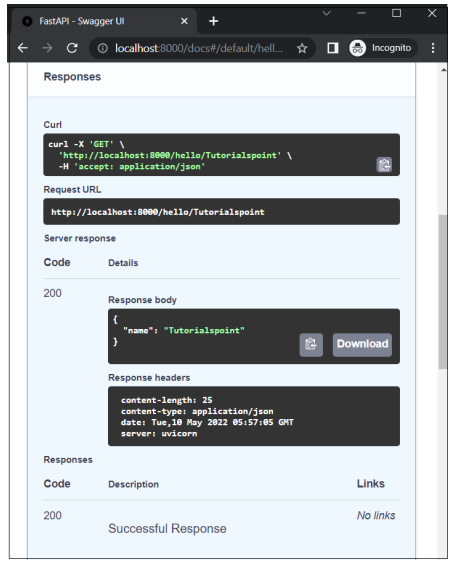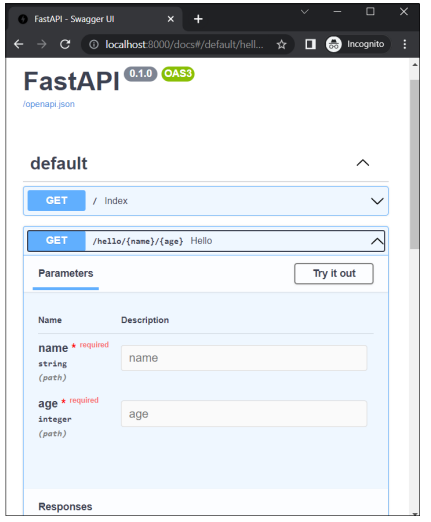
- FastAPI - Home
- FastAPI - Introduction
- FastAPI - Hello World
- FastAPI - OpenAPI
- FastAPI - Uvicorn
- FastAPI - Type Hints
- FastAPI - IDE Support
- FastAPI - Rest Architecture
- FastAPI - Path Parameters
- FastAPI - Query Parameters
- FastAPI - Parameter Validation
- FastAPI - Pydantic
- FastAPI - Request Body
- FastAPI - Templates
- FastAPI - Static Files
- FastAPI - HTML Form Templates
- FastAPI - Accessing Form Data
- FastAPI - Uploading Files
- FastAPI - Cookie Parameters
- FastAPI - Header Parameters
- FastAPI - Response Model
- FastAPI - Nested Models
- FastAPI - Dependencies
- FastAPI - CORS
- FastAPI - Crud Operations
- FastAPI - SQL Databases
- FastAPI - Using MongoDB
- FastAPI - Using GraphQL
- FastAPI - Websockets
- FastAPI - FastAPI Event Handlers
- FastAPI - Mounting A Sub-App
- FastAPI - Middleware
- FastAPI - Mounting Flast App
- FastAPI - Deployment
- FastAPI Useful Resources
- FastAPI - Quick Guide
- FastAPI - Useful Resources
- FastAPI - Discussion
FastAPI - Path Parameters
Modern web frameworks use routes or endpoints as a part of URL instead of file-based URLs. This helps the user to remember the application URLs more effectively. In FastAPI, it is termed a path. A path or route is the part of the URL trailing after the first /.
For example, in the following URL,
http://localhost:8000/hello/TutorialsPoint
the path or the route would be
/hello/TutorialsPoint
In FastAPI, such a path string is given as a parameter to the operation decorator. The operation here refers to the HTTP verb used by the browser to send the data. These operations include GET, PUT, etc. The operation decorator (for example, @app.get("/")) is immediately followed by a function that is executed when the specified URL is visited. In the below example −
from fastapi import FastAPI
app = FastAPI()
@app.get("/")
async def index():
return {"message": "Hello World"}
Here, ("/") is the path, get is the operation, @app.get("/") is the path operation decorator, and the index() function just below it is termed as path operation function.
Any of the following HTTP verbs can be used as operations.
| Sr.No. | Method & Description |
|---|---|
| 1 |
GET Sends data in unencrypted form to the server. Most common method. |
| 2 |
HEAD Same as GET, but without the response body. |
| 3 |
POST Used to send HTML form data to the server. Data received by the POST method is not cached by the server. |
| 4 |
PUT Replaces all current representations of the target resource with the uploaded content. |
| 5 |
DELETE Removes all current representations of the target resource given by a URL. |
The async keyword in the functions definition tells FastAPI that it is to be run asynchronously i.e. without blocking the current thread of execution. However, a path operation function can be defined without the async prefix also.
This decorated function returns a JSON response. Although it can return almost any of Pythons objects, it will be automatically converted to JSON. Further in this tutorial, we shall see how such a function returns Pydantic model objects.
The URLs endpoint or path can have one or more variable parameters. They can be accepted by using Pythons string formatting notation. In the above example URL http://localhost:8000/hello/TutorialsPoint, the last value may change in every client request. This variable parameter can be accepted in a variable as defined in the path and passed to the formal parameters defined in the function bound to the operation decorator.
Example
Add another path decorator with a variable parameter in the route, and bind hello() function to have name parameter. Modify the main.py as per the following.
import uvicorn
from fastapi import FastAPI
app = FastAPI()
@app.get("/")
async def index():
return {"message": "Hello World"}
@app.get("/hello/{name}")
async def hello(name):
return {"name": name}
Start the Uvicorn server and visit http://localhost:8000/hello/Tutorialspoint URL. The browser shows the following JSON response.
{"name":"Tutorialspoint"}
Change the variable path parameter to something else such as http://localhost:8000/hello/Python so that the browser shows −
{"name":"Python"}
Check OpenAPI docs
Now if we check the OpenAPI documentation by entering the URL as http://localhost:8000/docs, it will show two routes and their respective view functions. Click the try out button below /hello/{name} button and give Tutorialspoint as the value of the name parameters description and then click the Execute button.

It will then show the Curl command, the request URL and the details of servers response with response body and response headers.

A route can have multiple parameters separated by "/" symbol.
from fastapi import FastAPI
app = FastAPI()
@app.get("/hello/{name}/{age}")
async def hello(name,age):
return {"name": name, "age":age}
In this case, /hello is the route, followed by two parameters put in curly brackets. If the URL given in the browsers address bar is http://localhost:8000/hello/Ravi/20, The data of Ravi and 20 will be assigned to variables name and age respectively. The browser displays the following JSON response −
{"name":"Ravi","age":"20"}
Path Parameters with Types
You can use Pythons type hints for the parameters of the function to be decorated. In this case, define name as str and age as int.
@app.get("/hello/{name}/{age}")
async def hello(name:str,age:int):
return {"name": name, "age":age}
This will result in the browser displaying an HTTP error message in the JSON response if the types dont match. Try entering http://localhost:8000/hello/20/Ravi as the URL. The browsers response will be as follows −
{
"detail": [
{
"loc": [
"path",
"age"
],
"msg": "value is not a valid integer",
"type": "type_error.integer"
}
]
}
The reason is obvious as age being integer, cant accept a string value. This will also be reflected in the Swagger UI (OpenAPI) documentation.
